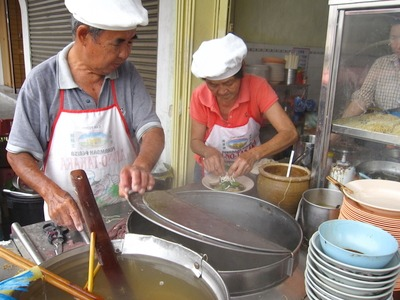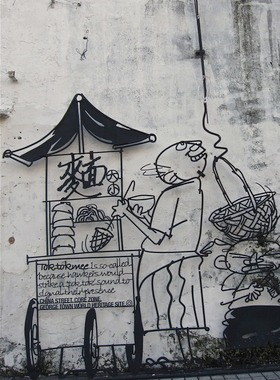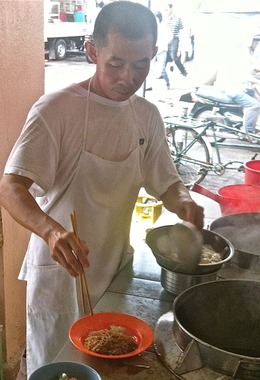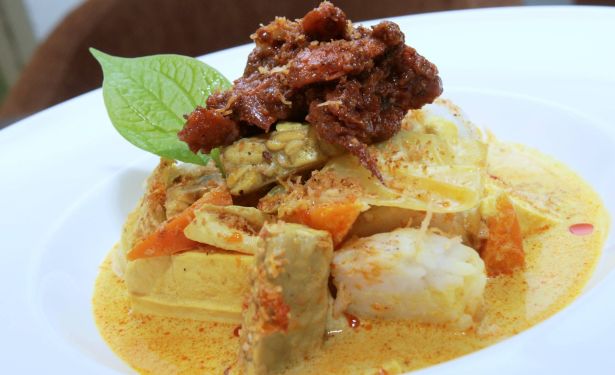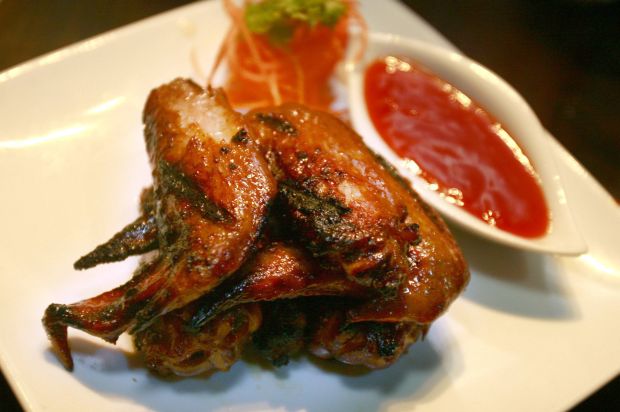Customers used to listen out for wandering tok tok mee vendors. Here are two permanent stalls they can head to.
AS a boy, Chan Chee Meng recalls vividly how his “boss” – a wantan min hawker – would knock two bamboo sticks together to attract customers to the latter’s humble stall in George Town.
Interestingly, that was how the famous Cantonese egg noodle dish soon became known among locals: tok tok mee.
“After school every day, I would help serve the customers, wash the dishes and even sometimes knock the two sticks together, for some pocket money.
“Those days, a filling bowl of noodles was only 10 sen,” says Chan, 65, who has been running his own successful tok tok mee stall for over four decades.
The dish became so popular and ingrained in local culture that the predominantly Hokkien-speaking community in Penang grew more accustomed to ordering it by its “informal” name instead of the Cantonese wantan min.
There’s even a sculpture in the heritage enclave explaining how the dish got its catchy name.
“Tok tok mee is 100% Cantonese,” says Chan.
“My father came from China to work as a furniture-maker before opening his own tok tok mee stall.
“By then, I had some experience to share with him from my part-time work but when he started his business, there was no more knocking of the bamboo sticks.
“He charged 20 sen per plate and now I sell my noodles at RM2.80,” he says, smiling.
After over 20 years of making his own egg noodles, Chan senior retired. The younger Chan says despite the hard work involved, his father did not believe in using ready-made egg noodles as his customers preferred the taste of homemade noodles.
“My father was a perfectionist who worked very hard and his customers appreciated that. It takes about two hours to make the egg noodles and this does not include the time needed to prepare the sauces and ingredients.
“I did everything like him, including making the noodles myself, when I took over the business.
“Finally, I just couldn’t cope and started sourcing for good quality egg noodles from a supplier. This means lots of eggs.
“Suppliers who are stingy with the eggs sell their noodles cheap and my customers can tell because the noodles turn soggy when blanched,” he says.
With his father’s and his own reputation at risk, Chan doesn’t compromise on the quality of the noodles. It’s just not worth losing your customers to make a few extra ringgit, he says matter-of-fact.
Although the Chan family business has moved about a few times in George Town, its loyal customers have grown steadily like a hungry avalanche rolling to wherever the stall moves to.
“They tell me they love the sauce mix.
“Unlike other stalls, we don’t offer the option of replacing the noodles with hor fan (flat rice noodles) here,” explains Chan.
Most customers prefer their tok tok mee “dry” (as opposed to it being served in a broth).
Chan’s daughter Mei Yeng, however, says a separate bowl of soup is almost always requested. Initially, the soup was free but now there’s a nominal charge of 30 sen.
“We wanted to stop making the soup because my parents are getting old and it’s quite a bit of work but our customers kept requesting it and we didn’t want to disappoint them,” she says.
The soup stock, left to simmer for some seven hours, is made from boiling a mix of bak kut (pork ribs), kang hu kia (anchovies) and lau keh bo (old hen).
Chan’s wife, Lean Yok Chan, 60, wakes up at 4am to get the stock and ingredients ready.
“It’s very important to get the lau keh bo because it adds a rich, hearty flavour to the stock. That’s why I only get the chicken fresh from the market. The soup’s ingredients are pricey,” she notes.
White is in
Chan points out that the dish has evolved and is quite different from the original version which only had char siew (barbecued pork), koo chai (chives) and boiled pork dumpling.
“The original tok tok mee is whitish in colour as no or tau eu (sweet black soya sauce) is used unlike the modern version.
“Now you have shredded chicken meat, chai sim (Chinese flowering mustard) and the option of deep-fried dumplings (although we don’t serve that) instead of the boiled ones.
“Also, I’ve added a bit of lor (corn starch mix in the Hokkien dialect) for a smoother sauce,” he says.
More customers ask for the “white version” these days.
“We were surprised that in the last few months, customers started ordering pek (white) tok tok mee even though it’s not on the menu.
“One of them told me that people are recommending it on social networking sites,” says Mei Yeng.
“Generally, most people find the dish’s pale appearance unappetising.” But Mei Yeng says that was how it was prepared in China in the old days and that’s exactly how she likes it, too.
She says it’s what she usually makes for herself before the stall closes for the day.
“I like the white version especially with lots of chai sim and our homemade sambal belacan, because you can really taste the light soya sauce mix and it’s more fragrant.
“The sweet black soy sauce masks the salty sauce,” she says.
The family says it’s difficult to get good help these days and can only cope with serving noodles and limited side dishes such as chai sim drizzled with mua eu (sesame seed oil) and soya sauce and sui kau (prawn dumplings) and wantan soup.
The wantan comes with the dish, so I highly recommend ordering the homemade sui kau and chai sim. It’s filling and probably one of the healthiest dishes around (as far as hawker fare goes). Because it’s not fried, minimal oil is used so it won’t leave you feeling stuffed and bloated – which is why it ranks highly on my breakfast menu.
The Chan family admits to being obsessed with the dish.
“Everywhere we go, we look for tok tok mee stalls to try. We’ve even tried the famous ones in Kuala Lumpur (Chee Cheong Kai at Petaling Street), Kedah, Singapore and Hong Kong.
“It’s great that my dad and I have a common love for tok tok mee in common – it’s how we bond,” Mei Yeng says.
Chan loves the egg noodles in Hong Kong because of the texture but says Singapore’s best lacks bee sor (aroma).
“I think most of Penang’s tok tok mee sellers do a good job – the taste is quite consistent because the dish is prepared the same way.
“The difference lies in the sauce mix, which basically comprises sugar, a dash of mua eu, light and dark soya sauce.
“Of course, different sellers would have their own ratio mix and add their own secret ingredient into the sauce,” he says. Chan says getting the sauce mix ratio right is crucial otherwise the dish will be either too salty or too sweet.
Although both Mei Yeng and her mother are more than capable of whipping up a plate, most regulars prefer Chan’s “magic touch”.
“We don’t take it personally when they specifically request for him because he is the tauke,” Mei Yeng shrugs, jovially.
While the stall is always crowded with hungry patrons, Mei Yeng doesn’t take it for granted. If she sees that a customer has not finished the dish, she always makes it a point to ask if there was something wrong with it.
“The satisfaction is when you see that someone has really enjoyed the meal, but when there are leftovers, you wonder if there was something not quite right,” she says.
Chan doesn’t know if his business will span into the third generation but there’s a glimmer of hope in his eyes when asked if Mei Yeng would take over.
“It’s entirely up to her whether she wants to take over,” he says.
“Neither I nor my late father expected to have such a strong following as we were just trying to earn an honest living.
“I am grateful for the customers who keep coming back and am genuinely surprised at their support. They patiently wait for their orders whenever it’s busy and I appreciate that,” he says.
The legacy lives on
Mei Yeng is the eldest of three girls. She and her sisters took turns at the stall back in the day.
“We helped out after school and on days that one of us could not make it, we would trade shifts. It really wasn’t easy back then. My father used to tell us how he only earned about RM60 a day and once, did not even have enough money to buy a chopping board.
“His customers slowly grew and many of those you see today have been eating our noodles from before – we weren’t always this popular,” the youthful-looking 40-year-old says.
The mother of one doesn’t see her daughter taking over the family business as she herself mulls over the prospect.
“I only started to help at the stall a few years ago after my father underwent a heart bypass surgery. My parents aren’t young anymore, so I do what I can to assist. As for whether I will one day take over, who knows? It’s very hard,” she says, smiling.
Watching Mei Yeng in her sports shoes and bandana whisk around, balancing bowls of noodles and soup, one can understand her hesitancy.
“The customer is always right and no matter what, we have to be polite. But being around the boiling soup stock and hot water for hours can make you testy as it affects your body temperature and temperament,” she points out.
Perhaps that’s why her cheeks are always a shade of rosy red!
A sticky affair
Since I was introduced to Chan’s tok tok mee recently by a friend (who always insists on her egg noodle fix whenever she comes back to Penang from wherever she is in the world), I’ve been a fan but it would be sacrilege not to mention my other favourite stall.
Like Chan, Ooi Eng Chuan is equally busy juggling orders right up till lunch time, especially on weekends. The 43-year-old inherited the family business at the Swee Kong corner coffeeshop in Pulau Tikus where the stall has been in operation for more than five decades.
His version of the tok tok mee is gooey – but in a good way. He adds a very thick, starchy corn flour gravy to every plate – his mother’s signature style.
“I think I’m the only stall that does it this way. Between my mother and I, we’ve been selling here for 51 years,” says Ooi, sporting his usual white Pagoda T-shirt, apron and, for as long as I can remember, a neat crew cut.
My great grandmother used to patronise the place religiously after visiting the nearby Sleeping Buddha temple on Burma Lane.
She used to refer to him as the “handsome young man” and when I tell him this, Ooi blushes.
“Aiya, lau liau (I am old already).
“Please take a flattering photo, OK,” he says in jest.
I always order the hor fan rather than the egg noodles whenever I’m at Ooi’s because they are just so smooth and tasty (the tok tok hor fan is similar to the char hor fan – another famous hawker dish, which is stir-fried in a wok – but only because of the sticky lor).
But whether it’s the hor fan or egg noodles that you order, make sure to ask for Ooi’s killer sambal belacan.
Oh, Ooi’s deep-fried wantan is very popular (although I prefer the traditional boiled version) so I do recommend you go a little earlier if you are planning on ordering it as a side dish.
Chan’s stall at Tai Wah Cafe, Jalan Argyll, opens from 7am to 11.30am (except Tuesdays), while Ooi’s is closed on Thursdays.

